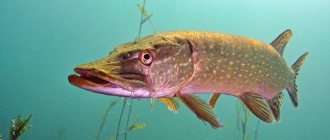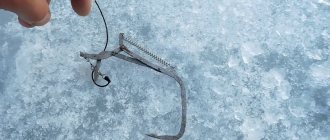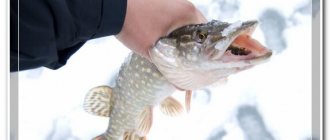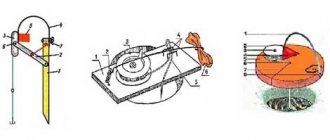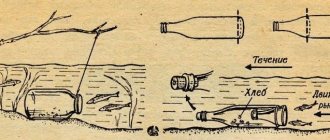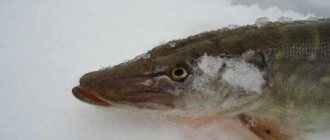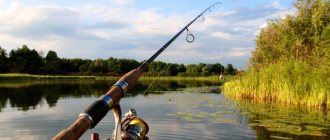In the fresh water bodies of Russia and the bays of the seas, the princess pike, beloved by fishermen, lives; the predator prefers weak or moderate currents, quiet backwaters, thickets of reeds and algae.
Find out how common pike grows and reproduces in nature and during home breeding, which one grows in a year, and how many offspring it bears. Do you like pike dishes?
- Yes 86%, 4064 votes
4064 votes 86%4064 votes - 86% of all votes
- No 10%, 491 votes
491 votes 10%
491 votes - 10% of all votes
- I don't eat fish 3%, 156 votes
156 votes 3%
156 votes - 3% of all votes
Total votes: 4711
18.06.2020
×
You or from your IP have already voted.
Common pike
The origin of the name of this fish is unknown. Some fishermen, especially Russian ones, believe that the predator was named after the shape of its body. Regardless of size, pike is always thin or frail (photo below). They claim that this is a derivative of the Old Slavonic “kill”, “cut”.
Description, appearance
Depending on growth conditions and food supply, pike in nature can grow up to 150 cm and weigh 35 kg. The pike's body shape resembles a torpedo. The head is large, with a very wide mouth. The color of the predator depends on the main colors of the soil of the reservoir, the transparency of the water and the colors of the main aquatic plants. The color of pike varies from gray-brown to gray-yellow.
The back is painted in darker colors, and olive or brown spots are scattered on the sides. The paired fins of the fish are colored in orange shades, while the unpaired fins are yellow-gray or dark red with dark spotting. You can catch an albino pike, its color is silver.
The female can be identified by the shape of the reproductive and waste openings. In them it looks like an oval depression in the body, which is surrounded by a pink cushion. In the male it has the shape of a narrow slit.
The lower jaw protrudes slightly forward; teeth are located here, capturing peaceful fish. They have different sizes. In general, the entire mouth and even the tongue of the pike are covered with several rows of teeth, the main purpose of which is not chewing food, but reliable fixation.
What family of fish do pikes belong to?
This question can be answered short and concisely. Pike are bony fish:
- class Ray-finned,
- order Pike-like,
- Pike family.
Types and varieties of pike
There are 5 main species of pike in the world's waters.
Two species have spread across Eurasia:
- ordinary, or northern;
- Amur
The three remaining species have spread across the waters of the American continent:
- the largest freshwater one is the Muskinong;
- striped species of predator;
- redfins.
One of the most common fish that lives in rivers and lakes of the Asian, European and American regions is the northern or common fish. The Amur species of predator is distributed throughout the Amur and its tributaries and on the Sakhalin Peninsula.
Redfin pike and its two subspecies (northern and grassy) are found in water bodies of the northern part of the American continent.
The largest freshwater pike is considered to be the muskie, but there is also an armored one that can live in the sea. These species, having reached 300–400 mm in length at 4–5 years, begin to spawn. The striped species of predator can be found in lakes with stagnant water or in river dams. It actively feeds on various types of invertebrates.
Predators of all species can interbreed with each other, this is due to the same number of chromosomes. But this can be done in fish nurseries. Small species become sexually mature at 2 years.
Shelled pike
This predator has not changed over the entire period of evolution. She lived on the planet during the era of dinosaurs. It can reach a length of 3 m, and inexperienced fishermen may mistake it for an alligator. Its second name is alligator fish. You can catch such a trophy on the coast of Cuba and the Caribbean. The eastern coast of Central and North America is a place where fans of catching trophy armored pike can enjoy landing a particularly large specimen.
Black pike
One of the striped subspecies, found in all freshwater rivers and lakes of North America. It is caught in Canada, on the Mississippi, and the Great Lakes. This small predator, 600 mm long and weighing up to 4 kg, is a desired trophy for every angler. This is a very beautiful fish, with a beautiful mosaic-like color on its sides, resembling an ordinary pike in appearance. The main distinguishing feature is a dark stripe on the head near the eyes.
Chukotka and Amur pikes
This fish is especially loved by our fishermen. Lives on the Amur. It is slightly smaller in size compared to the northern pike, but can provide many unforgettable minutes when fishing for a 20-kilogram predator that is 1 m tall. A distinctive feature is golden-green or silvery small scales with many black or brown dots on the body. In the wild you can find Amur or Chukchi pike aged 14 years.
Pike breeding
Depending on the type of pike, in a natural reservoir females can reach sexual maturity with a body length of 300 mm, and males 200 mm.
Pike spawning: how many times a year and at what time?
The predator spawns once a year, in early spring, at a water temperature of 60. This occurs in flooded meadows, immediately after the reservoir is freed from ice. Pike go to areas up to 1 m deep and rub against plants. Young females and males emerge first, then they are replaced by experienced breeders.
During this period, pikes move in small groups. One small female is “served” by 4 or 5 males. 7 males fertilize the eggs of large pike at once. At this time, you can see the protruding fins of the female in front and the males clinging to her. The fish is constantly in motion, the female rubs against the plants and lays eggs on them, the males release milk and fertilize future offspring.
After the female has laid all her eggs, the group noisily breaks up, going in different directions. During spawning, each female lays at least 17,000 eggs. But large individuals can produce 210,000 embryos. Eggs up to 3 mm in size stick weakly to plants and easily fall to the bottom after a few days. After 2 weeks the larvae appear. If the water temperature is between 5–100. After 6 days, the yolk sac completely resolves and the fry appear. Already at this age, the essence of future predators is visible - at this time, the fry actively eat eggs and larvae.
What does a pike fry look like and what is it called?
When a pike fry reaches a size of 12–15 mm, it begins to actively hunt for bloodworms, all kinds of crustaceans and small fish. He does not disdain weakened relatives. But it itself can become food for adult pike and perch.
In nature, no more than 5% of embryos survive to the period of active development and nutrition. Fishermen call the small predator a pike, a small-mouthed fish, or simply a lace.
How fast does pike grow?
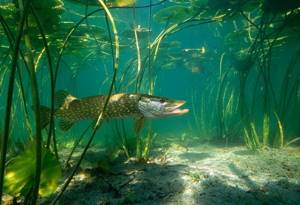
There are known cases of catching very large specimens of pike weighing 50 kg and 180 cm long. Its lifespan is approximately 30 years. It grows differently depending on age. Usually, 3-4 weeks after spawning, pike fry 3-4 cm in size appear from the eggs. If in the first year of life it reaches a length of 25-30 cm and weighs up to 300 grams, in the second year - 25-45 cm weighing up to 1.5 kg. In the third year it grows up to 60 cm and can reach a weight of just over 2 kg. A ten-year-old pike can weigh 10 kg with a length of 1 meter. The above factors also influence its growth. In cold times, especially in winter, pike growth slows down.
Pike biology
Having learned this information, you can understand why there are periods of no biting, although the statement that the pike does not hunt during teeth replacement is very controversial. But we'll talk about this later.
Pike scales - evolution, functions
In fish, scales began to appear during the period of evolution and replacement of the bony shell. This process began 50 million years ago. In all species of pike, except for the armored one and several of its subspecies, the shell has completely disappeared.
This property is especially important for pike when attacking. The scales allow you to move faster - this is due to the flexibility of the body and the elasticity of the entire layer of scales. Moreover, the mucus secreted on the scales significantly reduces the friction of the fish’s body when moving and serves as protection against certain types of bacteria and diseases.
How many teeth does a pike have and when does it replace them?
Both of these questions are incorrect. Let's explain why:
- The teeth of a predator cannot be counted. They are located along the entire plane of the mouth and even the tongue of the pike. They are not used for chewing food; their main task is to prevent the prey from leaving, securing it securely in the mouth. The teeth are arranged in dense groups and resemble a thick brush.
Three such stripes are located across the entire palate of the predator with small intervals. 4 brushes are on the tongue.
If you run your finger along them in the same direction as the fish moves into the intestines of the pike, the teeth will bend and let your finger through. Now try to pull your finger out, you will feel that the hooks are rising and the curved edges are preventing free movement.
- Pike teeth change gradually throughout the year. Therefore, it is impossible to name the period for tooth replacement. Some fishermen believe that changing cutters reduces the catchability of fishing in May. But this is not the reason for the failure. Young teeth cannot securely fix the fish in the mouth, so there are many empty bites and the catch size decreases.
But we repeat, there are no exact dates for changing teeth and there are no scientific calculations of the number of teeth in the mouth.
Pike eyes: how does it see under water and what color does it like?
There are many myths associated with pike. This also applies to her vision. The eyes are located quite high on the head, because of this the predator examines large areas of the reservoir, practically without moving its head. This is important when she is lying in ambush.
But the pike also “sees” the prey using the lateral line. It actively responds to all kinds of noise and vibration effects. The catchability of wobblers and their bladeless subspecies is based on this property.
But you can often observe the following picture. A pike will not attack a fish that suddenly appears, especially if it approaches from the side or from below. She will miss such prey. In general, this predator is a very lazy fish, especially in cold water. At this time, the pike does not react to an actively moving spinner; it likes slowly moving prey that does not need to be chased for a long time.
Does pike smell and what does it like?
Yes, pike can distinguish odors, but not at the moment of attack. Often it attacks a simple rag with bad odors, this especially often happens when the pike is feeding.
But in order for pike to determine the attractiveness and edibility of prey from a distance, fishermen will be helped by:
- the smell of blood,
- aroma of crustaceans,
- smells of herring or shrimp,
- From plant aromas, the smell of anise drops or garlic will attract you.
Spinning rod for pike fishing for beginners
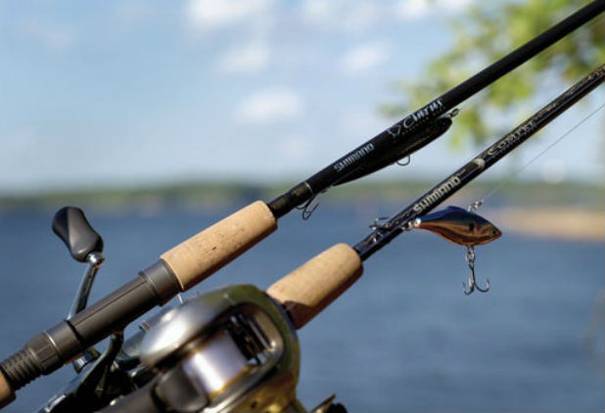
For those who are going pike fishing for the first time, it is worth starting by using the most universal tackle of a plug design, consisting of two sections, made of composite material, equipped with a set of rings with silicon carbide inserts and having the following parameters:
- fast or super-fast action;
- test 5-21, which works with almost all wobblers and spinners, as well as with medium silicone baits;
- The length of the form is 2-2.4 m, which is applicable for fishing both from the shore and from a boat.
Pike lifestyle
Pike is the queen of our reservoirs. But it is a mistake to believe that she has no enemies. An otter or muskrat will gladly feast on pike meat, and the young ones squint at their enemies even more. Both birds and large pike or perch attack the growing young.
Pike habitats
Pike is always in search of food, resting only for a short time. Therefore, it lives in places of active peaceful fish, depending on weather and climatic conditions. In general, this is a very unpretentious fish. She calmly tolerates salt water, actively feeds and hunts for frogs in overgrown swampy places. Even in reservoirs with a high content of hydrogen sulfide you can find a predator.
But on small lakes, even with holes and springs coming out, it will not survive when the water freezes to the bottom. But on deep rivers, if there is no wintering hole with springs, predators will leave in search of oxygen. Therefore, it is important to make ice holes and drill holes, especially during severe frosts.
Its favorite places to stop and ambush are the edges of holes or riverbeds, snags, thickets of reeds or aquatic plants. In summer it is better to look for it in shaded places; it does not tolerate heated water well.
Pike activity time
Pike can be caught all year round. But there are several periods when fishing enthusiasts give up everything. This time:
- spring - before the pike goes out to spawn, it begins a period of active hunting;
- immediately after spawning, she replenishes her strength and fattens;
- in the fall, at the first drop in temperature, the predator begins to fatten its fat reserves before the hungry winter.
The activity of fish is influenced by the number of small fish in the reservoir. If the pike is well-fed, only a well-chosen bait and correctly executed wiring can stir it up. Weather conditions and time of year: in summer and during the deep winter, one cannot count on good catches .
In terms of time, it is better to go fishing at dawn, at this time the pike is actively looking for food. You can safely stay at home if there is a period of extreme heat; in this case, pikes go deeper or into the shade and do not respond to bait.
How many years does a pike live: life expectancy in nature
It depends on her living conditions. First of all, the food supply affects. A well-fed predator living on a deep forest lake can live up to 20 years.
Nowadays, you can meet such a long-lived woman in sparsely populated places where there are no people. Otherwise, she will be caught using sporting or poaching gear.
And if you take into account the ecological situation on Earth, you can find large pike in the Far North or in Siberia .
How to determine the age of a pike by weight and size?
Pike grows for a short period of time each year.
Active feeding during the spring feeding period gives impetus to the development and growth of the predator’s body; this period ends with the first autumn cold snap and a decrease in water temperature.
In the southern regions, the pike gains a little length; in the north, the growth of the predator stops until spring.
Over the entire life cycle, the increase in length occurs unevenly:
- 1 year - weight 200–300 g, fish length 250–300 mm;
- 2 years - weight 500–1400 g, body size 250–450 mm;
- 3 years - pike weighs 700–2000 g and height 500–650 mm;
- If you come across a predator 1 m long and weighing 8 kg, then you are lucky to activate a 10-year-old fish.
The British claim that by catching a 16-kilogram fish, you have caught a predator that lives for about 40 years, but such data has no scientific confirmation. For the growth of squints, the number of peaceful fish and other prey in the reservoir is important. To gain 1000 g of weight, fish need to process up to 20 kg of frogs or fish. Therefore, she fills the stomach until it stops and then sits for up to 4 days, until the food is completely digested.
We can add to this that females always grow larger than males .
Relationships between pike and other fish
Pike have no relationships with other inhabitants of reservoirs. She perceives small fish as food, and tries to drive larger ones out of her hunting grounds. This is especially true for its eternal enemy - pike perch.
While the predator is small, perch can also hunt it, and every fisherman knows the cannibalism of pikes. Then it can become a trophy for birds of prey or animals. Otters and eagles actively hunt it.
Pike attack underwater
Pike attack prey from ambush. At different times of the year, the priorities of the predator change dramatically. If in summer it attacks actively moving bait, then in late autumn or winter it does not react to such prey.
It will attack fish that swim up to it from the side or from the surface of the water. This is due to her vision. It is important for her to detect prey and lead it until the moment of attack. By scanning the movements of the prey, the predator calculates the location and speed of attacking actions. Before throwing, the pike turns its head towards the fry and, as soon as they reach the intended line, hits the fish.
At the same time, she always tries to immediately place the bait across her body, then turns her head forward and immediately swallows it.
The benefits and harms of pike for humans
Pike meat and caviar are ancient dishes on the Russian table.
What are the benefits of pike meat and liver for humans?
Let's start with the fact that raw pike meat is a dietary product. 100 g contains 84 kcal. The high protein content combined with a low proportion of fat allows it to be used for gastrointestinal diseases and obesity. 98 kcal - this number of calories becomes after cooking pike; the calorie content also increases when frying meat - 122 kcal.
Meat and liver are rich in powerful natural antiseptics, which have a beneficial effect on strengthening the human body’s immunity. Fish contains:
- potassium;
- phosphorus;
- calcium;
- magnesium;
- iodine;
- iron;
- and a number of multivitamins.
Does pike have opisthorchiasis or other parasites?
Yes, there is a high probability of opisthorchiasis being present in the pike’s body. Pike actively feeds and lives in reservoirs rich in all species of the carp family, so there is a high risk of fish infection. But there are few such cases, especially if you compare the statistics of the disease in other fish.
The most important thing is not to eat raw fish that has not undergone heat treatment.
In any case, this is important to do, because the fish can have various types of worms in its body. There is nothing scary about this, the main thing is to process the pike well and fry it on all sides until completely cooked.
Maximum weight and size of pike
Each species of pike has its own record holders, so let’s look at this issue more broadly.
How to determine the weight of a pike by length?
Foreign fishermen, going to a reservoir for pike, must have a measuring instrument. Rods with rulers printed on them are often used. What is it for? Our table will help you answer.
The table can be continued, but the order of the numbers remains unchanged. Adding 50 mm of length adds about 300 g of weight. If you are lucky enough to catch an 800 mm predator, its weight will be 5 kg. The pike is measured from the jaw to the beginning of the tail.
Size and weight of trophy pike
Standard height dimensions are body length up to 1 m and weight 8–10 kg. Of course, they catch trophy fish, which are included in the record books. On remote rivers you may be lucky enough to catch a trophy up to 1.5 m long, but such cases are rare. They catch pike weighing 20 kilograms or more.
It is important to follow the fishing rules and release the strings into the river, but you can often find pike or pike perch at the market, which have nothing to eat. This is why you should be fined mercilessly.
Minimum size allowed for catch
Every fisherman going to hunt a predator must know the standard for catching the minimum size of pike. If the size of the bee-eater is less than 350 mm, you must release the fry back into the pond. This rule applies in Russia, Ukraine and Belarus.
If you go fishing in foreign countries, be sure to read the rules, otherwise your fishing experience will be limited to paying a fine and wasting your nerves.
Where to look and how to catch a huge pike?
You need to start looking for large pike at depth. She rarely hunts small peaceful fish, preferring to attack large individuals, and they feed at greater depths. A fisherman should know and follow several recommendations:
- Be sure to use a steel leash and strong fishing line or braid.
- To catch trophy specimens, use large baits. Their weight can reach 30 g; large fish will not attack small fish.
- It is easier to catch large trophies in deserted places and reservoirs. To do this, you will need to travel a long distance from home.
- When fishing, keep silence and do not wear colorful, bright clothes.
- The best fishing time is during the spring and autumn feeding periods.
- It is better to go fishing in the summer at dawn. Fish do not like warm water, and daytime fishing in summer will not bring results. But this does not apply to a cool, cloudy day; in such conditions it is active during the day.
- Look for the trophy in snags, on the edges of canals and holes - the fish likes to organize ambushes in areas with a bottom heavily overgrown with plants.
- When going after big fish, prepare several options for gear and a full set of baits.
The largest caught pike in the world
There are many myths about catching large specimens, but we will provide recorded information about trophy specimens:
- The Netherlands – one of the longest predators was caught here. Its length is 120 cm, but the fact of quickly catching such a large pike is also interesting. It only took 10 minutes.
- Canada - here the record improved for 3 days. First, a fish was caught - 118 cm, and after a short period a trophy was caught, the body length of which was 130 cm.
- Northern Lake Uvildy - a predator weighing 56 kg was caught here.
- In Russia, the most catching place of records is Lake Ladoga. 2 records registered. The oldest pike was caught here, 33 years old. And the trophy, weighing 4920 g, was caught by fishermen who were catching small squints using a wobbler. While catching a 5-kilogram predator, it was attacked by such a record-breaking specimen. It's amazing how easy it is to get her.
Pike fishing is an interesting and exciting activity for a large number of fishermen. Fans spend money on buying expensive baits, drop everything and go to remote places to catch a trophy. Join us, suffer from this harmless disease and enjoy the nature and resistance of the fish when playing.
onfishing.club
Building a spinning rod for pike
One of the important characteristics that you should pay attention to when choosing a spinning rod is its action. This indicator is associated with the bending of the form under load and indicates the distribution of flexibility and rigidity along its entire length. The action determines how far and how accurately the bait can be thrown, as well as whether the tackle will withstand the jerks of the fish when landing.

There are several types of structure:
- Very fast (type A) - only the tip of the rod bends, that is, a quarter of its length. With the ultralight action, high casting rigidity and accuracy are ensured, but its casting range is short, and shock mitigation is rather weak, which increases the load on the reel gearbox, fishing line and prey lips.
- Quick (B) - Three-quarter bend.
- Medium (half or C) - the form bends halfway.
- Slow (parabolic or type D), when almost the entire rod bends and provides the longest cast, although not very accurate. The jerks of the prey are noticeably softened, and accordingly the load on the fishing line and the reel gearbox is reduced.
The last two types of rod construction are the most popular among anglers. They have the advantages of types A and D, but without their disadvantages. Slow action is used very rarely when hunting pike, since it does not provide sharpness when fishing for a predator and does not allow you to cut through its hard mouth. There are also intermediate options:
- medium-fast;
- medium-slow.
The form structure is selected in accordance with the baits used:
- for silicone - from fast to very fast;
- for wobblers - from fast to medium-fast;
- for spinner spoons - from medium to medium-fast;
- for the vibrator - from slow to medium;
- Any popper is suitable, but for greater throwing accuracy and active play, it is better to use a fast one.
You may be interested in: Spoons
Types of pike
There are only seven species of pike in the world, two of which are found on the Eurasian continent and the rest in North America.
Lives on the territory of Russia
Common pike. Amur pike.
Inhabitants of North America
Black, striped or chain pike. Northern redfin. Southern herbal.
Muskie pike. Tiger pike or tiger muskie.
Another fish is called pike; it is a shellfish, which has no relation to the pike family and belongs to the ray-finned fish, which also lives on the American continent.
Pike pike
Record catch
In addition to fishing stories and legends, there are officially confirmed facts of the capture of giant fish.
- The largest pike caught in our country was caught in 1930. In Lake Ilmen, a fisherman managed to catch a toothy predator weighing 35 kg and 1.9 meters in length. Many fishermen say that their catch weighed much more, but they did not want to advertise this fact.
- In 1957, in North America, a huge fish, a muskie, was caught in the St. Lawrence River; its weight was 32 kg.
- Another giant pike was caught near the city of Sortavala. Her weight exceeded 49 kg. Such a large specimen was caught thanks to bait, while its role was played by another, smaller pike, with a body weight of 5 kg.
- In addition to the above facts, there are also other recorded catches of giant river predators. In Ukraine, in Lake Ladoga, local residents catch huge fish. Scientists have not been able to find out how long pike live in these places. Many fishermen claim that the age of the fish caught exceeds the 30-year mark. But this fact can neither be confirmed nor denied.
Common pike description of the species
Predator biology
The common pike (Esox lucius) has an elongated, log-like body, slightly compressed laterally. The animal's head appears elongated due to its long jaws. The upper jaw is flattened and descends at an angle to the lower jaw, which protrudes forward.
The back of the body sharply narrows from below and above by about half, turning into a V-shaped tail.
The body has two paired pectoral, abdominal and one dorsal and anal fins almost near the tail. All fins are rounded, including the tail.
The predator's eyes are large and located quite high, which allows it to control a large plane in search of prey and danger without turning its head.
The color of the common pike depends on its habitat and age; it can be grayish with shades of green, yellow or brown. The back of the predator is dark gray, sometimes almost black. Light spots are scattered throughout the body of young individuals, which at first glance seem like spots; with age, the spots become smaller and spread over the entire body except the back. The fins and tail are red with dark stripes or spots.
As you can see in the photo, the fish’s mouth is strewn with sharp teeth, the upper jaw has small brush-like teeth directed inward, and the lower jaw has large fangs.
When swallowing, the upper teeth press against the palate, pushing the prey into the larynx. The lower ones serve to hold the victim.
The fanged teeth tend to change periodically, which affects the size preference of the victims. Until the new ones get stronger, even the largest one chooses small prey.
Size
Fishermen divide common pike into two types: grass and deep.
- The herb most often lives in floodplain lakes, oxbow lakes and shallow rivers. The size of the predator rarely reaches 0.5 meters in length and weighs more than 2 kg.
- Deep pike is found in large lakes, reservoirs and rivers with depths of more than 5 meters, can grow up to 1.5 meters and weigh up to 35 kg. Fishermen most often catch 2-5 kilogram trophies.
In the southern regions rich in food resources, by the end of the first year of life the pup reaches 25 cm, with a maximum size of 90 cm by 5-6 years. Northern respectively 12 cm and maximum by 10-12 years
Females, usually larger than males, have less elongated bodies and live longer. Although fishermen divide pike into two species, this is most likely not the case; it is simply easier to hide in shallow water and not become a victim of their larger counterparts. And the food supply near the shore for growing small fish is richer. Growing pike move from shallow places to deeper places, sliding into pools and holes.
Leash
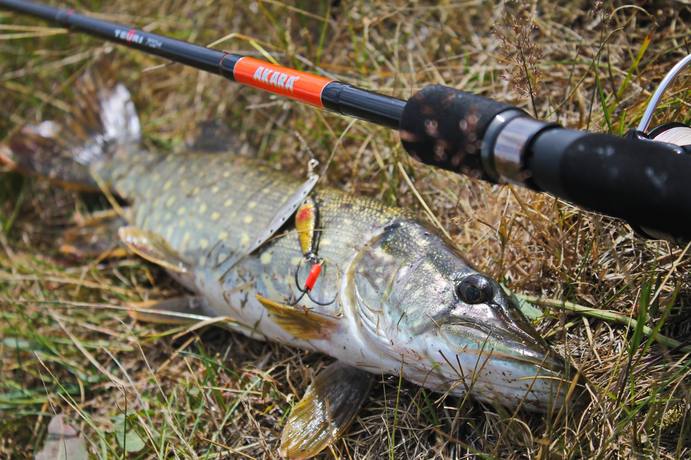
A toothy predator requires a strong leash, the length of which is from 15 to 25 cm. An opaque element of the equipment can be used when the pike is active, and in the passive period it is better to use a transparent one. Materials from which the leash can be made:
- Fluorocarbon or fishing line 0.3-0.5 mm thick will provide transparency and softness, but they are short-lived.
- Tungsten, the cable made of which is thin, soft, matte, which is good for camouflage, but is subject to deformation.
- A steel string that is strong and at the same time rigid, which inhibits play. With its shine, such equipment scares away fish, and also rusts, so it is better to use a specially produced leader wire that does not have such disadvantages.
At the border of the fishing line with the leash, a swivel is usually placed, which prevents it from twisting when inserting spinners. In addition, the pike leash should be equipped with a clasp or a winding ring for better play of the bait.
Lifestyle
For a normal life of a small 50 cm pike, an area of 20-30 square meters is sufficient. meters, for a large bottom inhabitant 50-70 square meters. meters. The area may be inhabited by several pikes. Which hunt in turns, while one digests food, the others sit in ambush. Larger specimens always displace their smaller counterparts from their homes.
With age, the common pike becomes a loner and prefers to sit in ambush, waiting for prey. Although if the food supply is small, it can move around the reservoir in search of food. Small squints are approximately the same size; sometimes they hunt in schools, accompanying the moving fry of other fish.
To search for prey, the pike uses the visual function and lateral line (seismosensory orientation), or uses the perception of the smell of the prey. Juveniles do not have the ability to sense chemical landmarks and feed only on moving objects.
Large pike have virtually no enemies, with the exception of humans, larger catfish and taimen. Therefore, in a hole where catfish stand or taimen hunt, you will not find pike.
Nutrition
Pike is an exceptional meat eater. Having hatched from the egg, it remains lying on the bottom in the spawning area for 8-12 days, until the yolk bubble disappears. Then, feeling hungry, it begins to spread out across the reservoir, sticking to shallow places and feeding on small invertebrates, worms and insects. They hunt fry of other fish species (perch , roach, crucian carp), starting in June, and already in August-September, fish predominates in their diet. Shchury pups grow very quickly, within a year they reach a size of 15 centimeters and a weight of 150 grams, and in the third year of life they reach 42 cm and weigh 600-700 grams.
Although pike prefers a fish menu, it can also eat small vertebrate rodents, chicks of waterfowl and frogs.
Feeding activity largely depends on water temperature.
Table of temperatures in degrees Celsius.
Typically, pike feed in the morning and evening, and rest during the day and night, digesting food. During zhora, which happens most often three times a year, it feeds almost around the clock, in which it is helped by the lateral line and sense of smell.
The first zhor occurs during the pre-spawning period - late February, March, early April. Second after spawning, May, early June. Third mid-August, September, mid-October.
Low, constant pressure has a beneficial effect on the activity of the predator. High, stable pressure, in good weather, puts her into a stupor. The longer this weather lasts, the stronger the hunger will be.
During the spring flood, a huge number of pike enter the floodplain to spawn; after spawning, they go back to the rivers. The hatched fry slide into small lakes and streams. Where, growing up, they kill almost all the fish of other species, their smaller brothers and even beetles. Sometimes you come across lakes in which there are no other fish except pike.
Spawning
The female predator reaches sexual maturity in the third or fourth year of life, the male in the fifth. In spring, when the water warms up to 3-6 degrees, spawning begins. Pike is one of the first to spawn, this is due to the fact that the growing small pike fish can feed on young cyprinids that spawn later.
Small young individuals are the first to enter the spawning area, gathering in shallow water in small groups of 4-5. The group usually includes 3-4 males and one female. A large female can have up to 8 males. The spawning small fish are followed by the turn of the medium and, at the end of the second week, the largest individuals.
Caviar, 2-3 mm in diameter, has a greenish-yellow color and, when properly salted, tastes very pleasant. The amount of eggs spawned depends on the size of the female; it can be from 17 to 215 thousand. Egging occurs in places with depths of 20-100 cm. Some of the eggs fall to the bottom, some stick to plants. After 3 days, all eggs fall to the bottom and continue to develop. The development of eggs depends on water temperature and can last from 8 to 14 days.
The hatched fry are 6.7-7.6 mm, rise to the surface, cling to plants with special protrusions on the upper unformed jaw and continue development until the yolk sac dissolves. After which they detach from the plants and begin to eat crustaceans and daphnia, developing and acquiring the appearance of a pike.
Having reached a length of 12-15 mm, squirrels begin to hunt for cyprinid fry. Growing up to 50 mm, the fish completely switch to feeding on fish. In reservoirs with a small food supply, fry 3-4 mm in size already resort to cannibalism.
If a pike of this size is kept in an aquarium and fed with crustaceans, it will soon die. The energy obtained from crustaceans is not enough for the life of a predator.
Sometimes the not very sticky eggs stick to the paws of birds devouring them and can be transported over considerable distances to bodies of water previously uninhabited by predators.
Reel seat, handle, rings
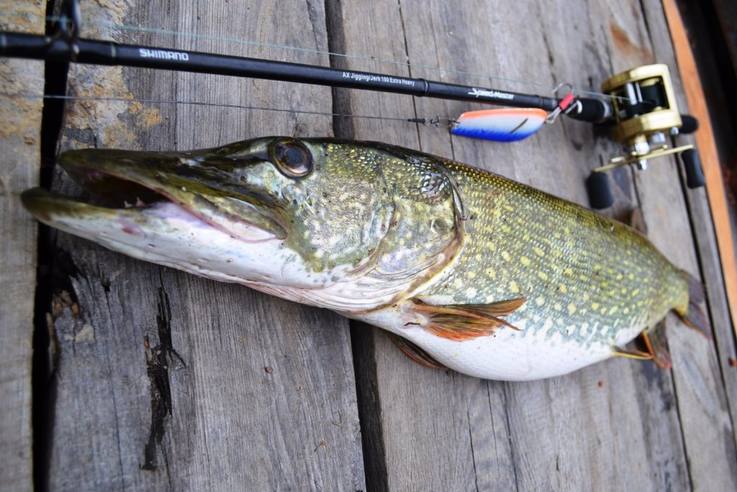
Since the responsibility for securing the reel to the rod lies with the reel seat, he is required to:
- reliability;
- ease of use;
- ease of attaching and releasing the reel.
To ensure that the reel can be twisted with one hand, a front mount is preferable. Spinning rods can be one-handed or two-handed, and the latter have a length of 2.8 to 3.3 m and are used for throwing as far as possible. Handle requirements:
- it should be comfortable;
- do not slip in a wet hand;
- ensure reliable retention of gear;
- be monolithic in material color and composition;
- have no dents or cracks.
You may be interested in: Taimen: the largest freshwater predator
The handles are made of polyurethane or cork, which is preferable when fishing in rainy, slushy weather or in cold weather. In order for the rings to be wear-resistant and not wear out the cord, the inserts must be made of:
- aluminum oxide;
- silicon carbide.
It is necessary to pay attention to the thickness of the inserts, as too thin ones quickly fly around and damage the fittings.
Cycle of life
There are legends that a pike can live up to almost 300 years and during this time reach almost 6 meters in length, but ichthyologists have proven that the age of the fish does not exceed 35 years, and the length is 2 meters. In the presence of a reservoir rich in food, pike fry in the first year reaches a size of 30 cm and a weight of 350 grams.
This is what the predator growth chart looks like, maximum dimensions.
By the age of 35, out of the same number of fry of females and males, only females remain, which reach 30 kg in weight and 1.8 meters in length.
Do I need to feed and what?
To provide the fry with food and increase their yield, part of the reservoir should be separated using a mesh with small cells. Up to 12 perches that have reached sexual maturity are released there. The young perch will be born later and will become food for the pike fry.
If there is not enough food in the pond, the growth of the fry slows down. In this regard, during the breeding of this fish, on the 15th day from the moment the larvae emerge from the eggs, they must be transplanted into a feeding pond. There the fry will be able to obtain food in the required quantity.
You need to know how to catch a fry without harming it. They should be caught with caution: water from the pond must be drained gradually, while simultaneously adding fresh water. It is easiest to catch fry using catchers directly in front of the spillway bed.
To prevent the fry from getting lost in the grass, it must first be mowed and removed.
How they catch
Amateur gear.
Pike is a predator and primarily feeds on fish; accordingly, it is caught with live fish or its imitation. Live bait is used for fishing, both in summer and in winter, with girders of various designs.
In summer they also use tackles, which come in different types.
Artificial baits for catching predators have a very wide variety.
Spoons.
- Oscillating (sound and normal).
- Rotating
- Combined
- Vertical
- Balancers
- Wobblers
- Poppers, spinners.
Jigs
- Twisters, vibrotails
Poaching
- Networks
- Dragnet
- valve
- Prison
- Trap
- Electric fishing rod
- Dynamite
Recreational pike fishing is carried out in several ways.
- Zherlitsy
- Spinning rods
- path
- Spearfishing
Unconventional fishing methods
- A loop
A thin copper wire with a loop is tied to the stick, which is put on a standing fish during the fishing process. The fishing rod jerks sharply upward, the noose tightens and the predator is trapped. If you don't have wire at hand, you can use willow root as shown in the video.
Pike in cooking
Although pike meat is not fatty (2-3%) and not very tasty, it is still an indispensable dietary product and when properly prepared, especially when fresh, it acquires a rather pleasant taste.
At different times, pike was treated differently. The ancient Romans did not eat it, the Don Cossacks generally considered it trash because it eats frogs, but in France it is in demand among French women, especially those watching their figure.
Pike is considered a commercial fish and is not only caught, but also raised on fish farms.
Spinning rod for catching pike from a boat
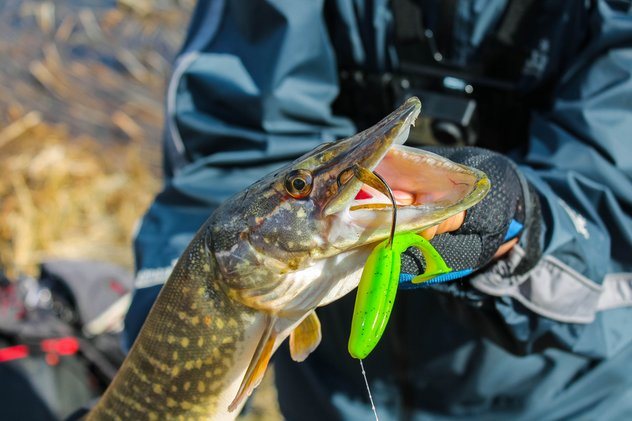
If you are going to fish from a boat, then the test and structure of the spinning rod are selected in the same way as when fishing from the shore:
- test when using light baits (up to 15 g) - 5-25 g, and for heavy ones (30, 40, 60 g) - 25-75 g;
- the rod can be taken as rigid as possible, with a very fast action, since the boat has the ability to maneuver.
The optimal length of the stick is 1.8-2.1 m.
